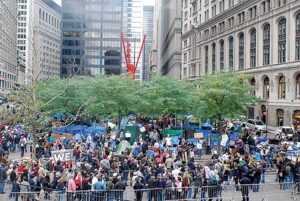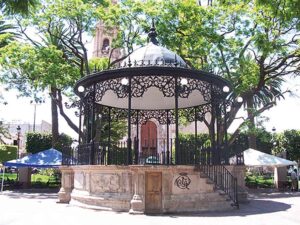by Pablo Halguera

Photo: David Shankbone
The original text is more academic in nature and some of that aspect is retained here; for that reason, this text departs slightly from my usual tone, but I still felt it would be worth sharing it as it touches on some topics I have addressed in the past particularly regarding socially engaged art.
In recent years, in the United States the term ‘creative placemaking’ has gained widespread usage in the spheres of urban design, public art, cultural development, and art education. The term is defined as ‘when artists, arts organizations, and community development practitioners deliberately integrate arts and culture into community revitalization work – placing arts at the table with land-use, transportation, economic development, education, housing, infrastructure, and public safety strategies.’
The term ’creative placemaking’ never entered into our lexicon until fairly recently. Rather, the focus of the debates over the last decade have included dialogic practices, the mediation between the visual and performance studies, spectatorship and antagonism and cooperation. Furthermore, the ideas around social practice over the last two decades have focused on people, not places, while remaining responsive to localities, the primordial principle is to follow common-held goals around topics like social justice and the transformative role of art in community work.
This recent new term usage by cultural policymakers in the United States has made the need to define the exact role of ‘place’ particularly important. The term place, in its most conventional usage, refers to a physical location, not a metaphorical one, and the term creative implies (but not exclusively refers to) art making. The liberal use of ‘creative placemaking’ as a catchphrase to attract funders and city governments, is used so widely to the point of meaning very little as a progressive form of art practice, particularly in the sense that the emphasis on physical location at times appears to displace people (for whom the place is ostensibly conceived to benefit). Most importantly – and this is why I believe this topic is relevant to the context of this biennial – it presents the question of what is the role of the term place in socially engaged art, and what does it mean to do socially engaged placemaking.
I.
My early experiences of public space dynamics is the public square in Mexico. The Spanish built cities that followed the predominant urban plan of the period in 16th century in Europe. This primarily meant that the most important buildings would be adjacent to one another in the center of the town. The organizing structure was the public square or plaza. (It is important to note that the governmental and religious and ceremonial center in Aztec culture was also located at the center of the city, as it was the case of the Templo Mayor in Tenochtitlán, today’s Mexico City, although the main center did not function in the same way of the European plaza).
Part of my family is from Lagos de Moreno, a medium-size town in the state of Jalisco. Every year or so we would visit relatives there. In contrast to the vast and chaotic metropolis that is Mexico City, Lagos was (and is) comparatively quaint and peaceful – a place where time seems to stretch for long periods. For us it was a place to get some rest, and there was not much to do other than walking around the town. At night, it was customary to walk to the main square where one would often socialize with others. My father, who had been going to Lagos since the 1930s, explained to me the dynamics of the plaza which to that day still held: teenage women in packs, paleta in hand, would walk around the plaza, and young men would interact them. The plaza was in this sense the location for romantic encounters and courtship.
Henri Lefevre (1974) argued that public space can be understood in three modalities: as ‘perceived space’, ‘conceived space’ and ‘lived space’, or rather, the space as it is intended, understood and used through daily practice. The plaza in Lagos, intended for public use, ostensibly was not ‘conceived’ for this kind of ‘lived’ courtship approach, albeit it could be argued that this particular use is comprised within the larger intention of making the urban space available for public use.
For those of us who work in the realm of either socially engaged art or architecture, we share an awareness of the gap between what is conceived or intended by the artist and the way it is inhabited, understood and used by others, and as such we need to be very intentional in the construction of those spaces, allowing that freedom of use as well as the malleability that others will give to that space. This means that a successful participatory model needs to take into consideration the agency of the potential user in adapting the environment to something that would meaningfully work for them.

(Jardín de los Constituyentes)
II.
The use of the square as an intentional pedagogical structure is particularly important in early education systems like Reggio Emilia. A system developed in the early years of the postwar era, Reggio Emilia educators sought to create a type of pedagogy that fully acknowledged and respected the identity and the human rights of the child and invited their creativity and their agency in the attainment of their own education, but at the same time promoting the idea that even at an early age an individual should understand and assume their role in civic society, thus hopefully becoming a good future citizen of the world.
This principle of the Reggio Emilia approach is best exemplified by the design of their schools, and modeled by the central Diana school, perhaps the most famous of all Reggio Emilia schools. The Diana, surrounded by beautiful gardens (the connection with nature is also an important component of the Reggio Emilia system) welcomes children every morning into an open space known as the Piazza, which functions as a microcosm of the public square. In the piazza, children gather for a range of learning activities that can be reconfigured by the instructors. The piazza system is central to the learning approach in several ways, as it offers children a level of agency to select the activities they will engage in, but also introduces, in a simple way, the public stage onto which we all need to engage with as part of civil society. In contrast to other systems that are very individually-oriented, the collaborative nature of many of the Reggio Emilia activities provide a practical way for children to appreciate the educational potential of cooperation and mutuality.
The teaching artists in the classroom guide the students through collective play to pursue their own ideas without losing sight of the uniqueness of each child. In referring to the multiplicity of ways by which we all learn, Loris Malaguzzi, a founding thinker of the Reggio Emilia approach, spoke of the “100 languages of children”, an idea that was later developed in cognitive psychology by Howard Gardner with his theory of multiple intelligence (Gardner, 1983). Last, but definitely not least, the concept of the piazza in Reggio Emilia is the crucial basis for the notion of the environment as a third teacher.
III.
In September 2011, the Occupy Wall Street movement emerged as a protest to the increasing economic inequality that had been greatly exacerbated by the 2008 recession and the greed shown by the corporate, mortgage, and financial services sector of the United States. Protesters had difficulty finding a location in the Financial district of New York City where to stage their activities, and finally centered on Zuccotti Park, which is a public space (POPS) owned by Brookfield Properties and Goldman Sachs. Protesters occupied the park four about two months.
It is important to note here that Occupy Wall Street protests, by virtue of their own existence, laid bare the fact that the notion of public space in American cities is very restrictive, as even when a place technically a public location (such as a city park) it is not possible to use it for a wide range of purposes.
Aside from its political/historical importance, what I want to note here is the particular kind of cooperative culture that emerged in Zuccotti Park. Quite a range of collective, communal and democratic activities were organized with the purpose of supporting the movement. These included the use of progressive stacks, allowing members of certain minorities the right to speak before the simple majorities, the use of the human microphone, whereby a single speaker’s voice is amplified by repeating their words by a whole group of people to give it greater volume, and the use of a wide range of communal resources, such as a people’s library, free workshops, activities for children, food, and many other forms of support.
Occupy Wall street was embraced and supported by many artists, but in the spirit of the movement, it did not have a specific leader nor a hierarchical structure.

I have laid out a brief description of three different dynamics in public spaces. One of them, the Mexican town plaza, was laid out by urban planners in a traditional way, leading to specifically developed rituals that are not exactly intended, but not entirely unexpected. The second is an intentionally constructed, and fictionalized, version of that space inside a Reggio Emilia school, with the explicit hope that the structure will allow for a certain level of agency by the user (the child) through pretend play but ultimately with the hopes that it will lead with the learning of a civic purpose ( i.e., the child becoming a future good citizen). And the third (Occupy Wall Street in Zuccotti Park) is a public space that was completely – albeit temporarily – reimagined in terms of its public use to produced conditions of mutuality.
None of these examples are explicit instances of architecture or art making, even if conventional aspects of urban or architectural design were sometimes part of the equation. Nonetheless, they offer a simplified taxonomy of models about the socially engaged role that the artist/architect can play in the construction of the socially engaged commons, a space that can integrate the free interpretive impulses of human beings in shaping their own environment without being overly prescriptive. Going back to Lefevre, intentionality, perception and actual use of the space are components that are all relevant in the construction of a project that could have the necessary malleability for its community of users to inhabit and transform it, while at the same time offer a structure that would encourage and support the social processes of bonding and conviviality that result in communal unity.
Practicing socially engaged ‘placemaking’ with these considerations in mind, and with the tools of architecture, can make the now oft-employed term of creative ‘placemaking’ truly become meaningful – no longer as an urban development strategy with a vague reference to cultural production but as an approach that explicitly embraces its role as an art form and also offers physical and situational conditions for communities to become stronger in their collaborative spirit.
A version of this text was written as a catalogue contribution for the Philippines Pavilion at the 2021 Venice Architecture Biennale titled Structures of Mutual Support, a project by architects Alexander Eriksson Furunes & Sudarshan Khadka. Erikson and Khadka developed the project around the term Bayanihan, a Filipino word used to refer to the spirit of mutual unity and cooperation and used to refer to the beautiful tradition in the Filipines of having a whole group of neighbors helping a relocating family by carrying their entire house on their shoulders.
